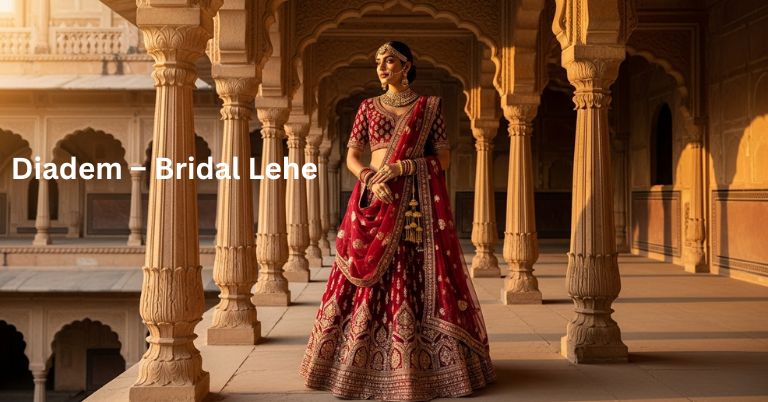When brides today look for something that feels fresh yet rooted, the diadem – bridal lehe style is often among the first that comes up. It’s not merely a fashion fad; it’s a graceful blending of two powerful elements – the diadem, a crown‑like headpiece and the bridal lehenga (or “lehe”). Quite simply, it offers a sense of being regal, without forsaking tradition.
What the Term Means and Why It Stands Out
When I say diadem – bridal lehe, I refer to the bridal ensemble in which a bride pairs a diadem (a tiara‑style headpiece) with a lehenga. In most South Asian weddings, brides don head ornaments like maang tikka or matha patti; but this trend shifts the focal point upward by placing a diadem at the crown or hairline. The bridal lehenga (or “lehe”) is the heavy, embellished skirt‑blouse‑dupatta set.
What makes this combination compelling is that it leans toward a royal aesthetic without losing cultural resonance. Many brides are drawn to it because it feels like a visual elevation, but still wears like a wedding outfit. It’s the kind of look that, most likely, photographs beautifully and feels memorable.
Why Brides Are Going for Diadem – Bridal Lehe
Here are some reasons this look is gaining traction:
- Royal Presence: The diadem adds a majestic aura. Even if the lehenga is heavy, the diadem gives your silhouette an elegant break.
- Fusion Appeal: Many brides want a mix of Eastern and Western influences. The diadem – bridal lehe look gives that.
- Photogenic Edge: In many bridal portraits, the diadem acts like a frame – catches light, defines structure and gives symmetry.
- Customization Flexibility: Because the diadem is a separate piece, it can be custom matched to the color, motif, or gem work of the lehenga.
- Trend Momentum: Designers and bridal boutiques are placing it in their latest collections, making it more visible and accessible.
For example, in bridal fashion reports of 2025, pastel lehengas with silver or pearl detailing have become more popular. Designers then match with lighter diadems so the headpiece doesn’t overpower the outfit.
Styling Tips to Make It Yours
In order to carry off the diadem – bridal lehe look gracefully, attention to small details is mostly what makes the difference. Here are tips to help:
1. Match Undertones in Metal & Stones
It is common for a gold or warm-metal diadem to be the most suitable accessory for a lehenga that features gold zari or decorations. If your embroidery consists of silver, platinum, or neutral tones, you should consider using a metal diadem that is either silver or white. They should feel as though they are a part of the same plot, rather than two different stories.
2. Plan the Dupatta Draping Smartly
Since the dupatta has the ability to either expose or conceal your headpiece, it is essential to drape it with careful consideration. Consider using a back drape or a side drape rather than entirely covering your head. This is one method that can be utilized. So that the headpiece may be seen through the dupatta, use a sheer or very light dupatta if you are required to drape over. In order to maintain flexibility, numerous bridal stylists recommend utilizing a two-dupatta technique, using one for concealing and the other for styling.
3. Keep Volume Balanced
It is best to avoid adding on equally hefty headwear when wearing a bridal lehenga because it is typically quite full. By using hollow frames or lighter alloys, a diadem that is less in weight can be of assistance. Balance is the most important thing. The diadem should be kept simple if the lehenga is heavy; on the other hand, if the lehenga is simpler, the diadem will be able to shine more.
4. Secure It Well, Test Movement
There is a possibility that a diadem will move if it is not correctly pinned, particularly when dancing or moving. While you are wearing it, you should try walking, sitting and even nodding your head. Request that your hairdresser use anchor pins or grips that are not noticeable. Perform the test in advance so that you do not have to make any adjustments during the ceremony.
5. Harmonize with Face Jewelry
Due to the fact that the diadem attracts attention, you do not want to throw off the equilibrium by placing an excessive amount of jewelry on your forehead. Choose a maang tikka or matha patti that is delicate so that it complements the diadem rather than competing with it. This is the case if you wear either of these.
6. Choose a Suitable Hairstyle
There are several other hairstyles that can serve as a nice anchor for the diadem, such as low buns, soft waves, or side braids. Steer clear of styles that have an exceptionally high volume and either tilt the headpiece or push it upward. Stability and elegance are the desired outcomes.
Traditional Headgear vs. Diadem Approach
| Feature | Traditional (e.g. Maang Tikka, Matha Patti) | Diadem Approach |
| Placement | Forehead / parting line | Hairline / crown |
| Visual Focus | Mid‑face emphasis | Upper‑face / silhouette effect |
| Weight | Generally lighter | Varies; can be heavier if elaborate |
| Styling Complexity | Moderate | Mostly higher – coordination needed |
| Best Use | Traditional weddings, temple rituals | Fusion weddings, grand themes |
Inspirations & Trends for 2025
Many bridal designers are now offering diadem sets or headpieces as part of their packages, recognizing the diadem – bridal lehe demand. In fashion shows and bridal expos, you’ll often see lehengas paired with minimalist, slim diadems that echo motifs from the skirt or dupatta. This coordinated styling is becoming quite common.
In bridal couture houses, pastel lehengas with pearl or silver embroidery are trending. In order to match, brides are choosing subtle diadems that bring attention without overpowering.
On social media, real brides share their moments with this look – some in deep jewel‑tones, others in soft pastels, always making their own tweaks.
That’s the spirit – adaptation, not replication.
Final Thoughts (More Personal Note)
If a bride were to ask me for advice regarding a diadem – bridal lehe, also known as a wedding lehe, I would encourage her to make sure that it is comfortable for her. Do not simply follow the trend simply because it is being trendy. When you want to draw attention to your features, create contrast or accent, and allow your lehenga to tell its own story, use the diadem to do all of these things.
Probably what makes that combination work so well is harmony: harmony between the metal and the needlework, harmony between the hairstyle and the piece, and even harmony between movement and stability. It is possible that the diadem will feel less like an accessory and more like a crown that you were always meant to wear if you prepare ahead and test things carefully.
Frequently Asked Questions (FAQs)
Q: Can I wear both a maang tikka and a diadem together?
A: Yes, though not always. It’s possible, but mostly it works only if both pieces are light and complementary. You don’t want one dominating the other. Sometimes brides wear a smaller maang tikka with a diadem that sits higher.
Q: Should the diadem mirror the motif of the lehenga?
A: It helps a lot. If your lehenga has floral motifs, filigree or vine work, the diadem can echo that. Matching elements make the overall look more coherent.
Q: Is a custom diadem necessary?
A: Not strictly. Many boutiques offer semi‑custom or adjustable diadems that you can tweak to your lehenga palette or gem choices. If your lehenga is highly unique, custom is safer.
Q: Does this style suit destination weddings or outdoor venues?
A: Yes, quite well – especially if you choose lighter fabrics, weather‑friendly dupatta drapes and secure pinning. Just make sure the diadem is firmly attached.
Q: Will the diadem cast shadows on my face in photos?
A: It might, depending on lighting. That’s why it’s good to test in a mock shoot – your photographer and stylist can adjust angles or reposition it slightly in order to avoid unflattering shadows.
Also Read: Luuxly.com Style: Elevating Modern Elegance with Purpose and Poise

I am a content writer with proven experience in crafting engaging, SEO-optimized content tailored to diverse audiences. Over the years, I’ve worked with School Dekho, various startup pages, and multiple USA-based clients, helping brands grow their online visibility through well-researched and impactful writing.


